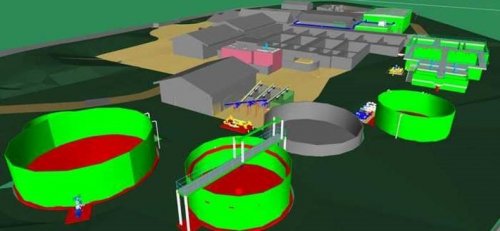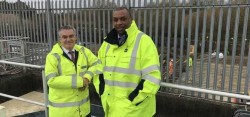South East Water's expansion of Bray Keleher Water Treatment Works is in full swing, with offsite manufacture aiding efficiency
Efficient construction processes and the use of precast concrete panels have enabled South East Water to make quick progress on a major expansion to its Bray Keleher Water Treatment Works near Maidenhead.
The £22M expansion project is an important part of South East Water's £424M investment programme for the 2015-20 AMP6 period. When the enlarged works is operational in 2020, it will see the Berkshire site expand in capacity from 45 ML/day to 68 ML/day, becoming South East Water's biggest treatment works. The extra capacity is required to enable future population growth and allow the water-only company to serve 150,000 customers across Berkshire, Hampshire and Surrey.
The Bray Keleher Water Treatment Works was built in the early 1990s and abstracts its raw water from the River Thames. It uses a multi-stage treatment process consisting of ozone pre-treatment; coagulation, flocculation and settlement; rapid gravity sand filtration; inter ozonation; GAC filtration; and disinfection by both UV treatment and chlorination. The expanded plant will follow the same treatment process, with the project adding tanks, channels and equipment at each stage to bring about the 50 per cent increase in capacity; there will also be a ramping up of the site's sludge treatment capabilities.
South East Water's Water Resource Management Plan, drawn up in AMP5, identified the need for enhanced supplies in the area to future-proof the network. Thankfully, it was envisaged at the time the plant was built that it may need to expand in future years, so the utility had sufficient land available and a layout that made expansion possible without demolishing the existing facilities.
"This is a very significant project for our company and we've had a lot of interest in it. It's the biggest scheme we've done in the last decade," says Desmond Brown, head of engineering at South East Water.
"In the planning stages we received a lot of support from residents and councillors; we hosted a number of community drop-in sessions which were well attended, and the mayor of Windsor and Maidenhead came to visit the site.
"Another thing that shouldn't be underestimated is the amount of internal communication and liaison. Our operations team have been involved right from the beginning, and we have a resource seconded from operations into our engineering team. We have found that very useful, saving a lot of time and effort - with a project like this it is key to get the operations team on side."

A digital model of Bray Keleher WTW, with the new sections in bright green
With planning permission secured, work began in the summer of 2018. One complication was that the earmarked land had previously formed part of a local landfill waste site, so contained contaminants including asbestos that had to be cleared before construction could start on the project. In total, 25,000 tonnes of earthworks were needed, with the material moved by a fleet of 40 heavy lorries.
BAM Nuttall and nmcn (formerly Nomenca) are the main contractors on the project, working in a joint venture as part of South East Water's Lot A framework, which covers major works. The first construction phase consisted of piling, followed by building the concrete bases of the tanks and units.
Around 350 specially designed precast concrete panels - supplied by manufacturer Kijlstra and imported from the Netherlands - are being used for the upright sections of the construction, the first time this approach has been used on this scale by South East Water. The precast panels are being built offsite and then brought to the site just in time for installation. This dramatically reduces the construction time required on site: for example, tanks that would require eight or nine weeks to build using in-situ concrete can be assembled in only eight or nine days. With space on site relatively constrained, the approach means the work can be achieved in the most efficient manner with vehicle traffic, health and safety risks, and total worker hours on site all minimised.
The design of the precast panels meant a high degree of collaboration was needed between client, contractors and the supply chain, explains Brian Steventon, project manager at South East Water.
"The model [showing the 3D design] has been shared between all of the supply chain," says Steventon. "It's been interesting to see the interface between the designers and the manufacturers. For example, when the panels are laid out they might want to put the rebars [reinforcing bars] in certain locations, which might not work with where the pipes go through, and in some cases we've had to move a pipe, in other cases move a rebar. It's been quite a detailed and challenging phase, and there's been some lively discussions."
The project is introducing some improvements to treatment processes and equipment. New baffles will be installed in the pre-ozonation tank to make this more efficient. The settlement phase in the expanded plant will include LSS88/88-05 Lamella Settlers, supplied by Hydro International, while TUBEdek Lamella Separation Tubular Settlers, supplied by 2H Water Technologies, were also recently installed in the existing plant. At the second ozonation stage (inter ozonation), ozone diffuser rods are being put in to replace diffuser domes, on the grounds that these have a reduced surface area and are easier to clean during the site's annual maintenance shutdown. Finally, the site's sludge treatment will be significantly enhanced, with a new blending tank, two thickening tanks and one tank for thickened sludge, all of which improve the quality of sludge and its reliability for being recycled to land.
Treated water from Bray Keleher feeds the Surrey Hills service reservoir from where it goes into the mains. Since this reservoir is also fed by Egham Treatment Works, which is run by Affinity Water (with any plant shutdowns needing to be covered by the other), the two companies have maintained a constructive dialogue about the project.
The project is currently on time and on budget. The construction phase is expected to be complete in March 2019, with the expanded plant being operational by November; this would be well in time to meet the March 2020 deadline required to fulfil the terms of the abstraction licence from the Environment Agency.










